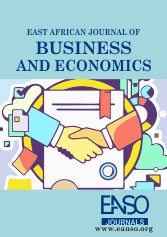Influence of Investment in Fourth Industrial Revolution (4IR) Technologies on Employment in Tanzania Manufacturing Sector
Résumé
The study assessed the influence of investment in 4IR technologies on employment in the manufacturing sector in Tanzania. Specifically, the study set out to establish the relationship and causality of investment in 4IR technologies on employment in the manufacturing sector. To achieve the research objectives, the study used a quantitative descriptive design to generate the required data. Moreover, the study used structured questionnaires for the cross-sectional survey, administered with 225 production managers of manufacturing industries in Tanzania. It used probability sampling in the form of cluster sampling. Additionally, the study used Pearson correlation and Ordinary Least Square methods to analyse the objectives of the study. This study has also revealed a strong positive correlation between investment in 4IR technologies and employment in the manufacturing sector. Further findings revealed a statistically significant causal effect between investment in 4IR technologies and manufacturing firms’ employment, whereby, when manufacturing firms increase investment in 4IR technologies by 1 unit, the employment level increases by 3.13 units. These findings are supported by the two-way graph, which portrays growth in employment level in the Tanzanian manufacturing sector as investment in industry 4.0 technologies increases. This study recommends that the government of Tanzania prioritise and invest further in technologically supportive infrastructure and enhance technical education for skills matching to fully embrace and harness the benefits of the Fourth Industrial Revolution. It further recommends that the Tanzanian Government review and improve its Sustainable Industrial Development Policy of 2020 and the Integrated Industrial Development Strategy of 2025 to promote and support not only resource-based industries, but also technology-based industries, to speed up industrialisation and employment within the country. The government should also improve its investment policies by aligning them with technological changes brought by 4IR, to attract more foreign direct investments (FDIs) that accelerate importation, adoption and imitation of 4IR technologies from developed countries for furtherance of industrialisation within the country
##plugins.generic.usageStats.downloads##
Références
Ayentimi, D. T., J. Burgess, and K. Brown. 2019. “A Conceptual Framework for International Human Resource Management Research in Developing Economies.” Asia Pacific Journal of Human Resources 56 (2): 216–237.
Diyamett and Makundi (2012). “Impact of ICTs Adoption and Application on Innovation in Selected Manufacturing Firms in Tanzania.” International journal of innovative technology and research
Fox, L., &Signe, L. (2022). Inclusion, inequality, and the Fourth Industrial Revolution (4IR) in Africa. Brookings Institution.
Gonese, D., &Ngepah, N. N. (2024). “Fourth industrial revolution technologies and sectoral employment in South Africa”. Cogent Social Sciences, 10(1), 2382282.
Kweka, J. 2018. “Monitoring policy to support industrialization in Tanzania.” UKAID. UK.
Lee, S., B. S. Kim, Y. Kim, W. Kim, and W. Ahn. 2019. “The Framework of Factors Affecting Technology Transfer for Suppliers and Buyers of Technology in Korea.” Technology Analysis & Strategic Management 30 (2). 172-185.
Maskaeva, A., Mmasa, J., Lema, N., & Msafiri, M. 2018. The Impact of Fiscal Reforms on Poverty and Income Distribution in Tanzania: A Computable General Equilibrium Analysis. PEP Working Paper. MPIA 19971.
Mela Research. (2023). The demography of Sub-Saharan Africa
Mertens. D. M. 2010. Research and evaluation in education and psychology: Integrating diversity with quantitative and mixed methods (3rd Ed.) Thousand Oaks, CA: Sage
Naudé, W. 2017. “Entrepreneurship, Education and the Fourth Industrial Revolution in Africa.” IZA Discussion Papers, No.10855. New Partnership for African Development New. 2013. “African Agriculture, Transformation and Outlook.” November 2013, www.nepad.org.
Nguvava, H. E. (2024). “Effect of Investment in Fourth Industrial Revolution (4IR) Technologies on Cost of Production and Sales Revenue of Manufacturing Industries in Tanzania”. International Journal of Economics, Business and Management, 8(11), 237-247.
Nicholas, Ngepah, Shaaba, Saba, David, Oluwaseu, Kajewole. (2024). “The impact of industry 4.0 on South Africa’s manufacturing sector”. Journal of Open Innovation, doi: 10.1016/j.joitmc.2024.100226
Odekunle, F. F., R. O. Odekunle, and S. Shankar. 2017. “Why Sub-Saharan Africa Lags in Electronic Health Record Adoption and Possible Strategies to Increase Its Adoption in This Region”. International Journal of Health Sciences 11 (4): 59–64.
Oketch, M. (2014). Education policy, vocational training, and the youth in Sub-Saharan Africa.WIDER Working Paper Series, 069. World Institute for Development Economic Research (UNU-WIDER).
Runde, D. 2016. “Is America ready for the ‘Fourth Industrial Revolution’?” Foreign Policy. https://foreignpolicy.com/2016/04/04.
Salam, U., Lee, S., Fullerton, V., Yusuf, Y., Krantz, S., and Henstridge, M. 2018. Tanzania case study: “Rapid technological change – challenges and opportunities.” Pathways for Prosperity Commission Background Paper Series; no. 7. Oxford, UK.
Schwab, K. 2017: The Fourth Industrial Revolution. New York: Random House USA Inc.
Sudman, 1983. “Survey Research and Technological Change” in Sociological Methods & Research, vol, 12(2), Pages 217-230.November.
World Bank. (2024). Distribution of the population of Sub-Saharan Africa from 2010 to 2022, by age group. Statista.
Copyright (c) 2025 Heriel E. Nguvava, PhD, Evelyne Sylvester Mwambije

Ce travail est disponible sous la licence Creative Commons Attribution 4.0 International .




























